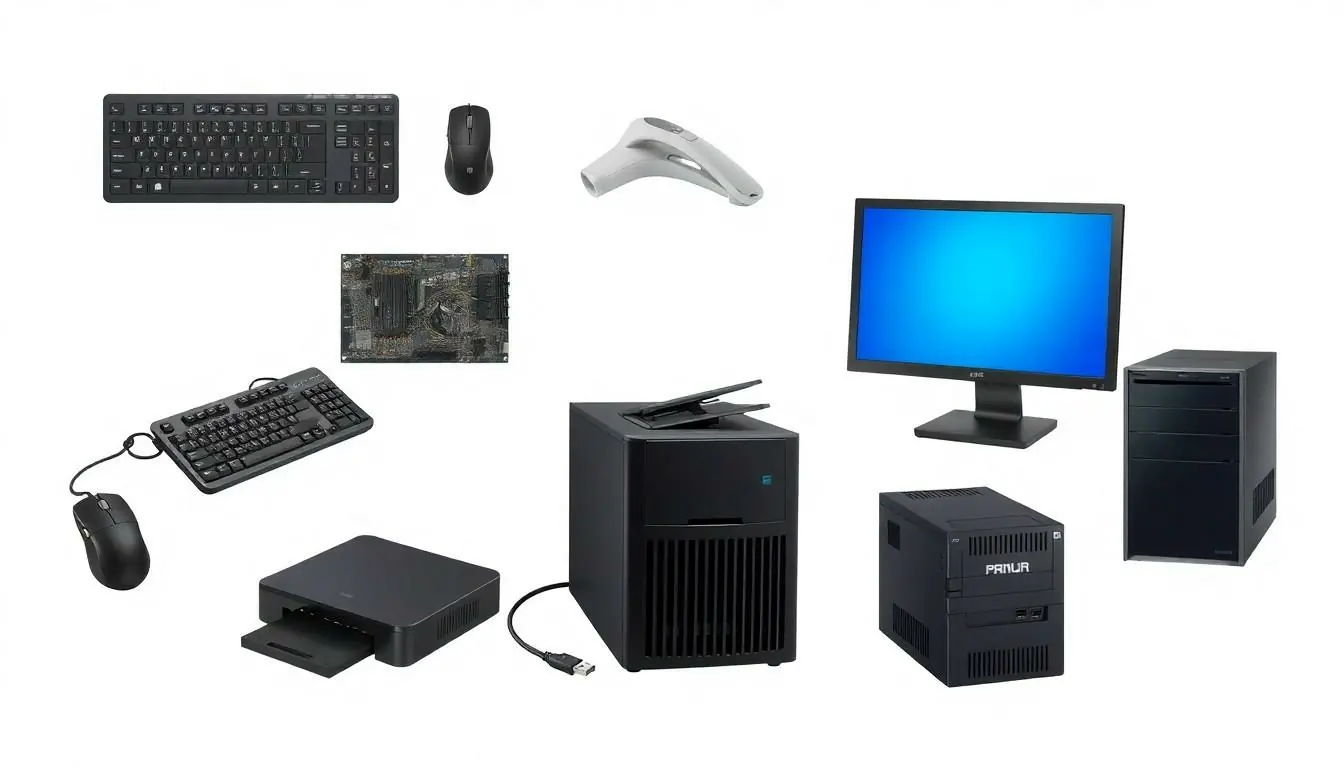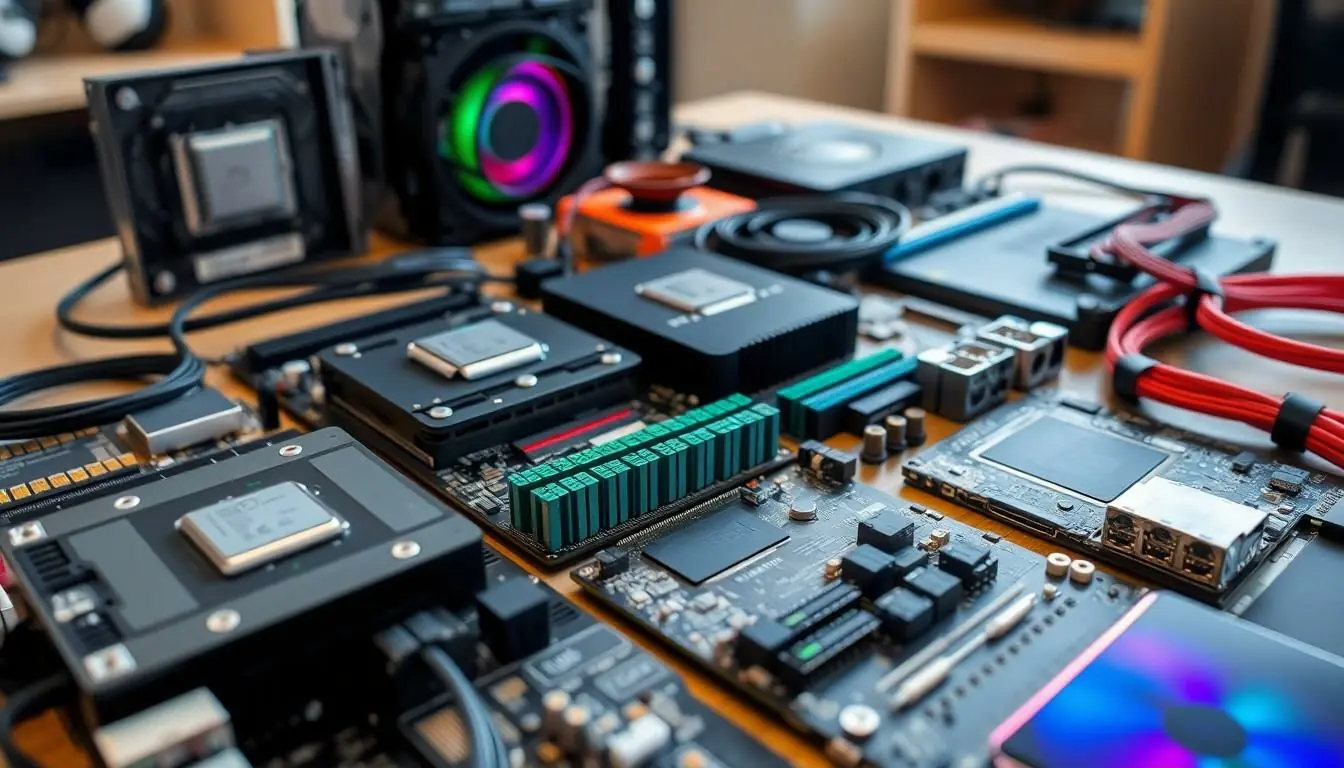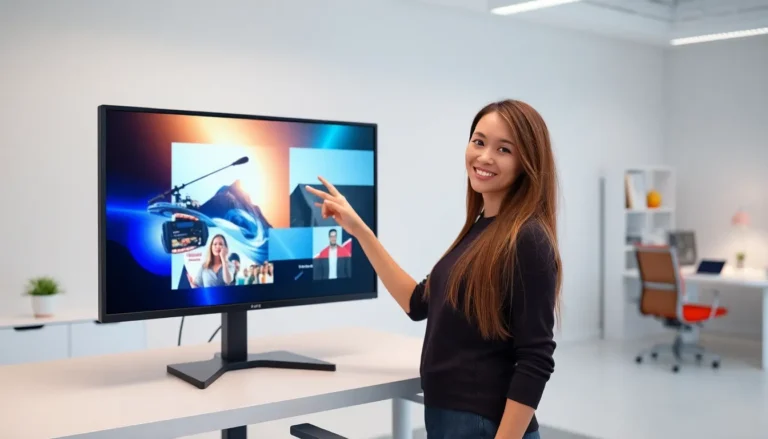Table of Contents
ToggleIn the vast universe of technology, computer hardware is like the sturdy backbone of a superhero—without it, everything falls apart. But what exactly qualifies as hardware? Is it just the shiny box sitting on your desk, or does it include that mysterious collection of wires lurking behind your monitor?
Overview of Computer Hardware
Computer hardware includes all the physical components that make up a computer system. Essential parts include the central processing unit, commonly known as the CPU, which performs calculations and processes data. Memory components such as random access memory (RAM) temporarily store information, allowing quick access and manipulation.
Storage devices like hard disk drives (HDD) and solid-state drives (SSD) serve as long-term data repositories. Input devices such as keyboards and mice allow users to interact with the computer. Output devices, including monitors and printers, present data in readable or usable formats.
Motherboards play a crucial role as they connect all hardware components, facilitating communication. Power supplies provide the necessary electricity to run the system, ensuring all parts function effectively. Expansion cards, such as graphics cards and sound cards, enhance a computer’s capabilities.
Cabinet enclosures protect and house these components. Various cables and connections, such as USB and HDMI, also form part of hardware, linking devices and enabling data transfer. Each of these elements contributes to the overall performance and functionality of a computer, highlighting the importance of understanding computer hardware in its entirety.
Through familiarity with these components, users can make informed decisions about upgrades and repairs. Recognizing which elements are hardware enables better troubleshooting and system optimization.
Types of Computer Hardware

Computer hardware comprises various essential components that enable a computer system to function optimally. Understanding these types helps users grasp their roles effectively.
Input Devices
Input devices capture user commands and data. Common examples include keyboards, mice, and scanners. Each device serves a unique purpose; keyboards enable typing while mice facilitate navigation. Scanners convert physical documents into digital files, enhancing accessibility. Touchscreens also fall under this category, allowing direct interaction with visual displays. These devices collectively enable efficient user interaction and control over the computing experience.
Output Devices
Output devices display or deliver processed data to users. Monitors, printers, and speakers represent notable examples. Monitors project visual information, providing real-time feedback. Printers produce hard copies of documents, enabling physical representation of digital content. Speakers convert digital audio signals into sound, contributing to multimedia experiences. These devices play a vital role in communication and presentation of information effectively.
Storage Devices
Storage devices retain data for long-term use. Hard disk drives (HDD) and solid-state drives (SSD) are among the most prevalent. HDDs store information on magnetic disks, enabling larger capacities at lower costs. SSDs, in contrast, utilize flash memory, allowing for quicker access speeds and greater durability. USB flash drives provide portable storage, facilitating easy data transfer. Understanding these devices supports better data management and retrieval strategies.
Processing Units
Processing units execute instructions and perform calculations crucial for functioning. The central processing unit (CPU) stands as the primary component, handling most tasks. It interprets data from memory and executes commands from input devices. Graphics processing units (GPUs) assist with rendering images and videos, enhancing visual output. Additionally, multi-core processors allow for parallel processing, significantly improving overall performance. Recognizing the importance of these units aids in appreciating their contributions to computing efficiency.
Examples of Computer Hardware
Computer hardware consists of tangible components that enable a computer system to function. The following sections explore essential components and peripheral devices that enhance computing experiences.
Essential Components
Central processing units perform calculations and process data, enabling computation. Random access memory temporarily stores information for quick retrieval, ensuring smooth operation. Storage devices, including hard disk drives and solid-state drives, keep data accessible over the long term. Motherboards connect these components, facilitating communication between them. Power supplies convert electricity, providing necessary power to the entire system. Expansion cards enhance capabilities with specialized functions, such as improved graphics and sound. These key components form the foundation of computer hardware, significantly impacting performance and efficiency.
Peripheral Devices
Peripheral devices interact with the main computer system and extend its functionality. Input devices like keyboards and mice allow users to enter commands and navigate interfaces easily. Scanners capture physical documents for digital use, enhancing productivity. Output devices include monitors that display visual information and printers that produce physical copies of documents. Audio devices like speakers present sound, completing the multi-media experience. Lastly, USB flash drives serve as portable storage solutions, enabling data transfer between systems. These peripherals play essential roles in user interaction, providing critical functionality and enhancing productivity.
Importance of Computer Hardware
Computer hardware forms the foundation of any computing system. Without robust hardware, a computer cannot function effectively. Each component plays a specific role that contributes to overall performance and efficiency.
Central processing units (CPUs) serve as the brains of the computer, executing instructions and managing operations. Random access memory (RAM) temporarily stores data, allowing quick access for active tasks. Both elements significantly enhance computing speed and efficiency.
Storage devices, including hard disk drives (HDDs) and solid-state drives (SSDs), ensure the retention of data. HDDs offer larger capacity, while SSDs provide faster access times. Users benefit from knowing the strengths of each type for specific needs.
Input devices like keyboards and mice facilitate user interactions, while output devices such as monitors and printers present data in usable formats. These interfaces are crucial for effective communication between the user and the system.
Motherboards connect all hardware components, enabling communication within the system. Power supplies deliver the necessary electricity for smooth operation. Recognizing the importance of these foundational parts aids users in understanding system functionality.
Expansion cards, including graphics and sound cards, enhance capabilities and enable additional features. Cables and connections, such as USB and HDMI, are also part of hardware, allowing for seamless data transfer between devices. Awareness of these elements contributes to efficient troubleshooting and system optimization.
Categorizing hardware into types helps clarify their roles. Input and output devices are key to user interaction. Understanding these principles enables informed decisions when upgrading or repairing systems, ensuring optimal performance of computers.
Understanding computer hardware is essential for anyone looking to optimize their computing experience. Each component plays a crucial role in overall performance and functionality. From the processing power of CPUs to the storage capabilities of HDDs and SSDs, every part contributes to how efficiently a system operates.
Recognizing the differences between input and output devices enhances user interaction and productivity. Moreover the importance of motherboards and power supplies cannot be overlooked as they ensure all components work together seamlessly. By familiarizing themselves with these elements users can make informed decisions about upgrades and repairs, ultimately leading to improved system performance and longevity.






